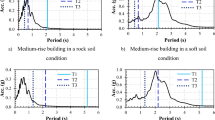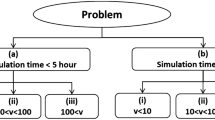Abstract
When the limit state function (or performance function) of a structure can be written as the difference of a capacity function and a response function that are expressed in terms of independent sets of random variables (i.e., when the limit state function has a separable form), efficient simulation based techniques (e.g., Separable Monte Carlo Simulation method) can be used to predict the reliability of the structure. The accuracies of these simulation based techniques, on the other hand, diminishes as the structural reliability increases. This paper proposes a reliability index extrapolation method to predict reliability of a highly safe structure that has a separable limit state function. In this method, the standard deviations of the random variables that contribute to the capacity function are artificially inflated by using a scale parameter to obtain various (smaller) scaled reliability index values (that can be predicted accurately with small number of samples). The standard deviations of the random variables that contribute to the response function are kept unchanged in order to use the same response values in prediction of various scaled reliability indices. Then, least square regression is used to build a relationship between the standard deviation scale parameter and scaled reliability index values. Finally, an extrapolation is performed to estimate the actual (higher) reliability index. The accuracy of the proposed method is evaluated through reliability assessment of mathematical and structural mechanics example problems as well as a reliability based design optimization problem. It is found that the proposed method can provide reasonable accuracy for high reliability index estimations with only 1000 response function evaluations.









Similar content being viewed by others
References
Acar E (2011) Guided tail modeling for efficient and accurate reliability estimation of highly safe mechanical systems. Proc Inst Mech Eng C J Mech Eng Sci 225(5):1237–1251
Au SK, Beck J (2001) Estimation of small failure probabilities in high dimensions by subset simulation. Probab Eng Mech 16:263–277
Ba-abbad MA, Nikolaidis E, Kapania RK (2006) New approach for system reliability-based design optimization. AIAA J 44(5):1087–1096
Botkin ME (1982) Shape optimization of plate and shell structures. AIAA J 20(2):268–273
Breitung K (1984) Asymptotic approximations for multinormal integrals. J Eng Mech 110:357–366
Bucher C (2009) Asymptotic sampling for high-dimensional reliability analysis. Probab Eng Mech 24:504–510
CALFEM - A finite element toolbox to MATLAB, Version 3.3 (1999) Lund University, Structural Mechanics and Solid Mechanics
Gondal ZR, Lee J (2012) Reliability assessment using feed-forward neural network-based approximate meta-models. Proc Inst Mech Eng O J Risk Reliab 226(5):448–454
Hasofer AM, Lind N (1974) An exact and invariant first-order reliability format. J Eng Mech 100(EM1):111–121
Huang B, Du X (2006) Uncertainty analysis by dimension reduction ıntegration and saddlepoint approximations. J Mech Des 126(1):26–33
Iman RL, Conover WJ (1980) Small sample sensitivity analysis techniques for computer models, with an application to risk assessment. Commun Stat Theory Methods A9(17):1749–1842
Kaymaz I (2005) Application of Kriging method to structural reliability problems. Struct Saf 27(2):133–151
Kim NH, Wang H, Queipo NV (2006) Efficient shape optimization under uncertainty using polynomial chaos expansions and local sensitivities. AIAA J 44(5):1112–1116
Koutsourelakis PS, Pradlwarter HJ, Schueller GI (2004) Reliability of structures in high dimensions, part I: algorithms and applications. Probab Eng Mech 19:409–417
Maute K (2009) Design element toolbox. Center for Aerospace Structures, University of Colorado, Boulder
Melchers RE (1989) Importance sampling in structural systems. Struct Saf 6:3–10
Picheny V, Kim NH, Haftka RT, Quiepo NV (2008) Conservative predictions using surrogate modeling. 49th AIAA/ASME/ASCE/AHS/ASC structures, structural dynamics, and materials, April, Schaumburg, IL
Picheny V, Kim N-H, Haftka RT (2010) Application of bootstrap method in conservative estimation of reliability with limited samples. Struct Multidiscip Optim 41(2):205–217
Qu X, Haftka RT (2004) Reliability-based design optimization using probabilistic sufficiency factor. Struct Multidiscip Optim 27(5):314–325
Rackwitz R, Fiessler B (1978) Structural reliability under combined load sequences. J Comput Struct 9:489–494
Ramu P, Qu X, Youn BD, Haftka RT, Choi KK (2004) Safety factor and ınverse reliability measures. 45th AIAA/ASME/ASCE/AHS/ASC Structures, Structural Dynamics, and Materials Conference, Paper No. AIAA-2004-1670, Palm Springs, CA, April 2004
Ramu P, Kim NH, Haftka RT (2010) Multiple tail median approach for high reliability estimation. Struct Saf 32(2):124–137
Ravishankar B, Smarslok BP, Haftka RT, Shankar BV (2010) Error estimation and error reduction in separable Monte-Carlo method. AIAA J 48(11):2624–2630
Rubinstein RY (1981) Simulation and the Monte Carlo method. Wiley, New York
Sichani MT, Nielsen SRK, Bucher C (2011) Applications of asymptotic sampling on high dimensional structural dynamic problems. Struct Saf 33:305–316
Smarslok BP, Haftka RT, Carraro L, Ginsbourger D (2010) Improving accuracy of failure probability estimates with separable Monte Carlo. Int J Reliab Saf 4(4):393–414
Tvedt L (1990) Distributions of quadratic forms in normal space – application to structural reliability. J Eng Mech 116(6):1183–1197
Wu Y-T (1994) Computational method for efficient structural reliability and reliability sensitivity analysis. AIAA J 32:1717–1723
Wu YT, Shin Y, Sues R, Cesare M (2001) Safety-factor based approach for probability-based design optimization. Proceedings of the 42rd AIAA/ASME/ASCE/AHS/ASC Structures, Structural Dynamics, and Materials Conference, Paper No. AIAA-2001-1522, Seattle, WA, April 16–19
Author information
Authors and Affiliations
Corresponding author
Rights and permissions
About this article
Cite this article
Acar, E. A reliability index extrapolation method for separable limit states. Struct Multidisc Optim 53, 1099–1111 (2016). https://doi.org/10.1007/s00158-015-1391-0
Received:
Revised:
Accepted:
Published:
Issue Date:
DOI: https://doi.org/10.1007/s00158-015-1391-0




